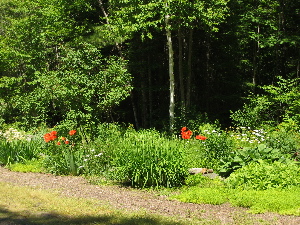AMPHIBIANS AND REPTILES
Spring really is just around the corner. I received a newsletter from the New Hampshire Wild Life/Fish and Game Department.
The major concern at this time of year is frogs or amphibians, and reptiles. It's breeding time and we need to give these little guys all the help we can. Very often frogs cross roads to get to their breeding sites. On rainy evenings, there are frogs hopping all over the roads we travel. We need to give them deference! I know that sounds kind of silly, “Give Way to Frogs!” But they really do need our help. Some of these little guys are endangered. Let me quote from the article I got.
“The spring migration of reptiles and amphibians will likely be going full tilt by the end of this weekend if the rain arrives. With frogs and salamanders out and about, Fish and Game needs volunteers to send observations to its Nongame and Endangered Wildlife Program. Through the Reptile and Amphibian Reporting Program (RAARP), volunteers report sightings of reptiles and amphibians, from spring peepers to snapping turtles. Many of the tools that RAARP volunteers use are now available on website including reporting forms, identification keys, documentation photo tips and much more.
The 2005 RAARP summary report is also posted, with an interesting list of the species seen in the 404 reports volunteers sent in last year. One of the best results of the year was the number of Blanding's, spotted and wood turtles reported. The most commonly reported frogs were green frogs, American toads, wood frogs and spring peepers. No mink frogs were reported in the state. Mink frogs have a distribution north of the White Mountains, so RAARP volunteers in northern N.H. are being encouraged to keep an eye out for them. Listen for their call (sounds like hitting two boards together). If you are fortunate enough to capture one, try to take a good photo! Careful, though -- mink frogs can look very similar to our more common green frog. Mink frogs are so named because, if disturbed, they smell like either mink or rotten onions. Later this year, Fish and Game also needs verified reports of leopard frogs (photos are crucial); focus searches for these amphibians during late
summer in floodplains, fields and agricultural areas along rivers.
And don't forget snakes. Hognose snakes are state threatened, and their sandy habitat continues to be developed in southern New Hampshire. To protect this species, we need to document the best places hognose snakes still occur. Other snakes in the greatest need of additional reports are timber rattlesnake, black racer, ribbon snake and smooth green snake. All snakes are underrepresented, though, and we need more reports on them.
Get involved as a RAARP volunteer -- email wilddiv@wildlife.state.nh.us or call (603) 271-2461 and ask for the RAARP Volunteer Packet.”
So there you have it. Get involved if you can!
Spring really is just around the corner. I received a newsletter from the New Hampshire Wild Life/Fish and Game Department.
The major concern at this time of year is frogs or amphibians, and reptiles. It's breeding time and we need to give these little guys all the help we can. Very often frogs cross roads to get to their breeding sites. On rainy evenings, there are frogs hopping all over the roads we travel. We need to give them deference! I know that sounds kind of silly, “Give Way to Frogs!” But they really do need our help. Some of these little guys are endangered. Let me quote from the article I got.
“The spring migration of reptiles and amphibians will likely be going full tilt by the end of this weekend if the rain arrives. With frogs and salamanders out and about, Fish and Game needs volunteers to send observations to its Nongame and Endangered Wildlife Program. Through the Reptile and Amphibian Reporting Program (RAARP), volunteers report sightings of reptiles and amphibians, from spring peepers to snapping turtles. Many of the tools that RAARP volunteers use are now available on Fish and Game's website at , including reporting forms, identification keys, documentation photo tips and much more.
The 2005 RAARP summary report is also posted, with an interesting list of the species seen in the 404 reports volunteers sent in last year. One of the best results of the year was the number of Blanding's, spotted and wood turtles reported. The most commonly reported frogs were green frogs, American toads, wood frogs and spring peepers. No mink frogs were reported in the state. Mink frogs have a distribution north of the White Mountains, so RAARP volunteers in northern N.H. are being encouraged to keep an eye out for them. Listen for their call (sounds like hitting two boards together). If you are fortunate enough to capture one, try to take a good photo! Careful, though -- mink frogs can look very similar to our more common green frog. Mink frogs are so named because, if disturbed, they smell like either mink or rotten onions. Later this year, Fish and Game also needs verified reports of leopard frogs (photos are crucial); focus searches for these amphibians during late
summer in floodplains, fields and agricultural areas along rivers.
And don't forget snakes. Hognose snakes are state threatened, and their sandy habitat continues to be developed in southern New Hampshire. To protect this species, we need to document the best places hognose snakes still occur. Other snakes in the greatest need of additional reports are timber rattlesnake, black racer, ribbon snake and smooth green snake. All snakes are underrepresented, though, and we need more reports on them.
Get involved as a RAARP volunteer -- email wilddiv@wildlife.state.nh.us or call (603) 271-2461 and ask for the RAARP Volunteer Packet.”
So there you have it. If you live in New Hampshire, get involved if you can!





0 Comments:
Post a Comment
<< Home